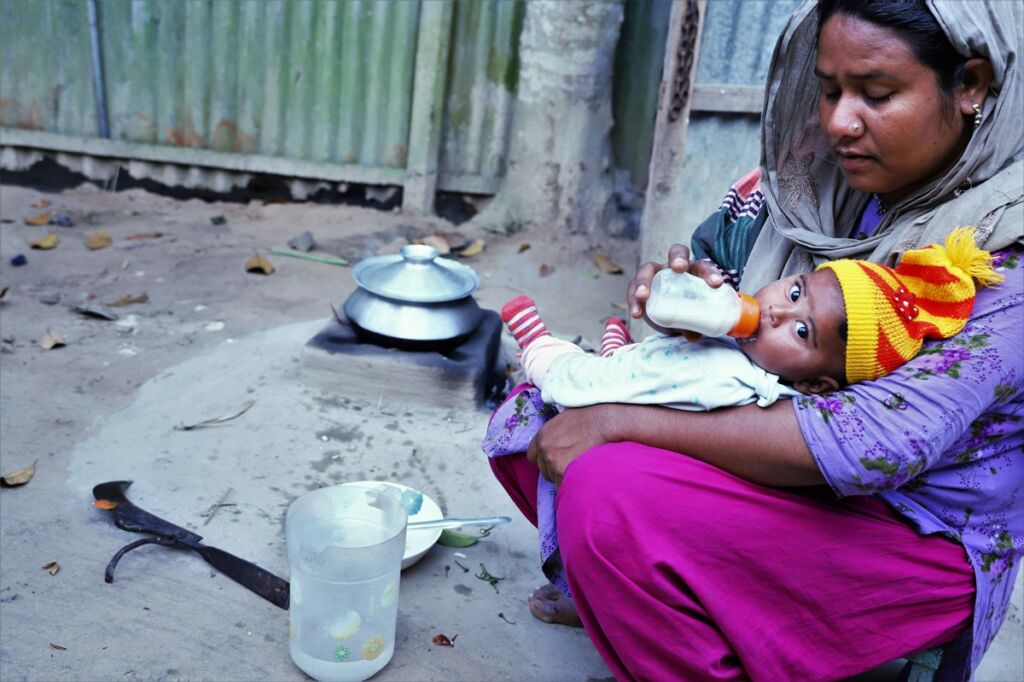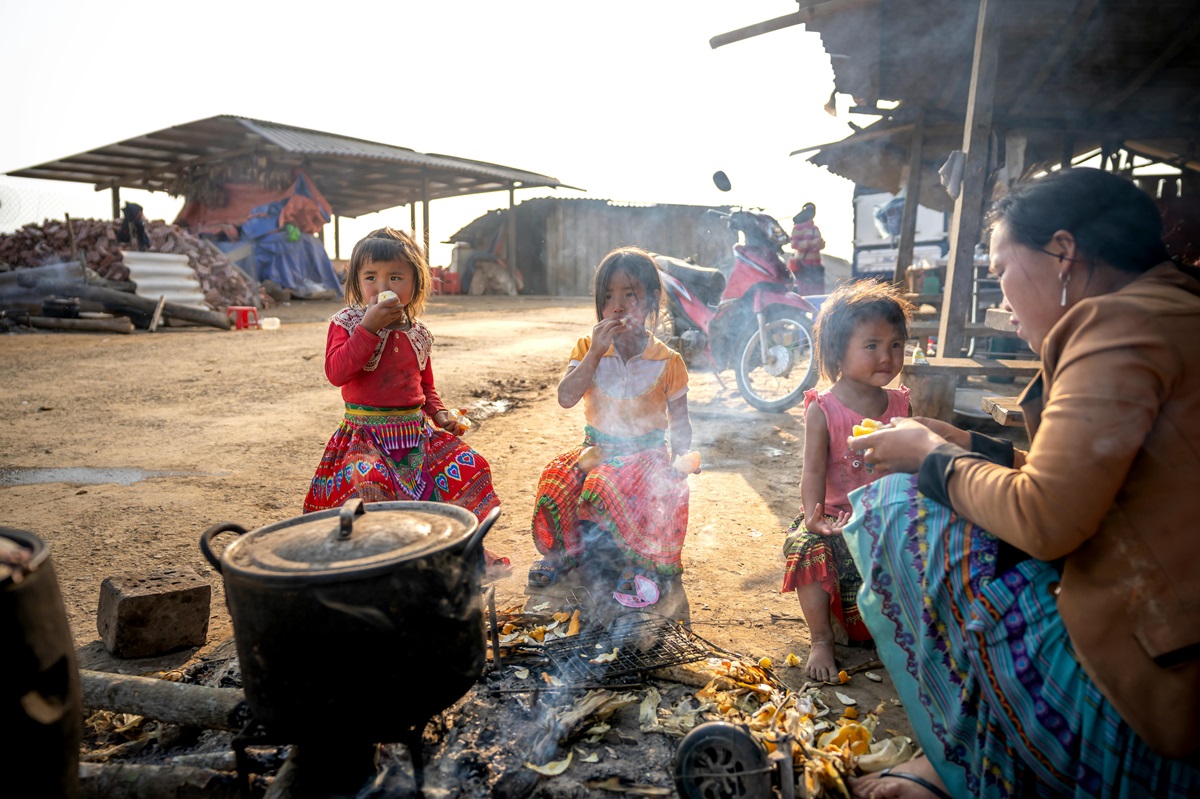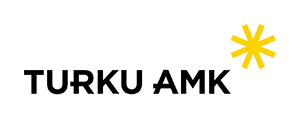Family poverty and its link to child nutrition and possible overweight

Early infancy and childhood are critical periods in the shaping of lifetime weight development. There is a critical period in the development of children under two years of age when the risk of malnutrition, overweight and nutrient deficiencies increase, if diet, practices and supplementation are not appropriate. In addition, lower socioeconomic status in adolescence is associated with higher BMI decades later.
In Latin America, the whole food system and diet is changing. A major shift has taken place in the availability, convenience and consumption of ready-to-eat, ready-to-heat, processed and packaged foods and beverages. They contribute to the increase in overweight and obesity. The quality of diets varies according to household purchasing power and neighbourhoods. Healthy foods are often more expensive and less accessible.
A barrier to eating a healthy diet is the inability to afford it
A large proportion of children from wealthier households and children living in urban areas have diets that meet the nutritional recommendations, unlike children from the lowest wealth class or those living in rural areas. A barrier to eating a varied and healthy diet is the inability to afford it. Even for infant children, there are significant differences in diets by neighbourhood and wealth.
Studies show that in Mexico, a large proportion of poor households have access to enough food to meet their energy needs, but the diet is often of poor quality and nutrient-poor. In Chile, on the other hand, food consumption is adequate, but food is not sufficiently varied.
There is a link between ethnicity, socioeconomic status and obesity.
Children from ethnic minorities are at significantly higher risk of unhealthy weight gain. Children from ethnic minorities, who often live in poor neighbourhoods with fewer healthy food options and fewer opportunities to exercise and play in parks and playgrounds, are at higher risk of poverty and isolation. This means that there is a link between ethnicity, socioeconomic status and obesity. The association between socio-economic status and unhealthy weight development is weakened by other factors such as maternal nutritional status and maternal education.
Early exposure to financial hardship increases the risk of overweight
Food insecurity is when a person cannot afford to eat enough and does not know when the next meal will be available. Food insecurity is a major problem in America, affecting 44 million people each year, 13 million of whom are children. Food insecurity is known to have a significant impact on health and well-being.
Life course studies show that early exposure to financial hardship in life increases the risk of overweight or obesity in adulthood, regardless of adult socio-economic status. Annual poverty statistics from age 0 to 16 years distinguish four childhood poverty pathways: persistent poverty, early childhood poverty, declining poverty, and poverty-free.

Those groups with persistent poverty and early childhood poverty have a higher risk of adult overweight or obesity than the poverty-free group. The risk of overweight or obesity is not significantly different between the persistent poverty group and the early childhood poverty group. Declining poverty in the absence of early childhood poverty does not significantly increase the risk of adult obesity.
Parental income and maternal education are associated with family eating habits
In low-income countries, household wealth and maternal education have been found to be associated with childhood overweight, while in high-income countries, overweight appears to be more prevalent in low socioeconomic status and less educated groups. The results are inconsistent in middle-income countries, such as Latin America, where rapid changes in the food environment have occurred, leading to an increase in overweight. In most Latin American countries, less educated women were more overweight, but child obesity also increased as maternal educational attainment and wealth increased.
Lower socio-economic parents are less likely to model healthy eating habits, less sensitive to children’s hunger and satiety cues and more likely to use food as a reward or comfort compared to higher socio-economic parents. Parental feeding strategies are both associated with emotional overeating. There is evidence that parents from lower socioeconomic status are more likely to use food to calm their child’s emotional states. Parents’ emotional eating behaviour teaches the child to use food as a coping mechanism for emotional stress.
In addition, for children from low socioeconomic backgrounds, a longer night’s sleep predicted a lower body fat percentage and sleep problems predicted a higher waist circumference and risk of overweight or obesity. In contrast, longer night sleep predicted lower BMI and reduced risk of overweight or obesity in all children regardless of socioeconomic background.
What is Cielo?
Cielo-project (Innovative Curriculum for Latin America to Build Capacity in HEIs to Prevent Obesity), is run by 3 European and 9 Latin American universities, specifically from the countries of Chile, Costa Rica, and Mexico.
You can read more about the treatment and management of childhood obesity in the previously published articles:

Authors
Saranda Hakanpää
Public health nursing student
Turku University of Applied Sciences
Tiina-Tuulia Kaukonen
Public health nurse
Turku University of Applied Sciences
Noora Lehto
Public health nurse
Turku University of Applied Sciences
Maika Kummel
PhD, Principal lecturer, Public health nurse
Turku University of Applied Sciences
References
Atalah, E.; Amigo, H. & Bustos, P. 2014. Does Chile’s nutritional situation constitute a double burden? American Society for Nutrition. Vol. 100, 1623–1627.
Batis, C.; Mazariegos, M.; Martorell, R.; Gil, A. & Rivera, J. 2019. Malnutrition in all its forms by wealth, education and ethnicity in Latin America: who are more affected? Public Health Nutrition. Vol. 23, No. 1, 1– 12.
Breitenstein, R. S., Doane, L. D & Lemery-Chalfant, K. 2019. Early Life Socioeconomic Status Moderates Associations Between Objective Sleep and Weight-Related Indicators in Middle Childhood. Sleep Health. 2019 October; 5(5): 470–478.
Eagleton, S.; Na, M. & Savage, J. 2022. Food insecurity is associated with higher food responsiveness in low- income children: The moderating role of parent stress and family functioning. Pediatric obesity.
Gassmann, F.; De Groot, R.; Dietrich, S.; Timar, E.; Jaccoud, F.; Giuberti, L.; Bordon, G.; Fautsch-Macías, Y.; Veliz, P.; Garg, A. & Arts, M. 2022. Determinants and drivers of young children’s diets in Latin America and the Caribbean: Findings from a regional analysis. PLOS Glob Public Health. Vol. 2, No. 7.
Kininmonth, A. R., Smith, A. D., Llewellyn, C. H. & Fildes, A. 2020. Socioeconomic status and changes in appetite from toddlerhood to early childhood. Appetite, 146. 104517. ISSN 0195-6663.
Li, M., Mustillo, S. & Anderson, J. 2018. Childhood poverty dynamics and adulthood overweight/obesity: Unpacking the black box of childhood. Social Science Research. Volume 76, November 2018: 92–104.
Picoito, J., Nunes, C. & Loureiro, I. 2020. Early Individual and Family Predictors of Weight Trajectories from Early Childhood to Adolescence: Results from the Millennium Cohort Study. Frontiers in Pediatrics, 11 August 2020. Sec. Pediatric Gastroenterology, Hepatology and Nutrition. Volume 8 – 2020.
Popkin, B. & Reardon, T. 2018. Obesity and the food system transformation in Latin America. Obesity reviews. Vol. 19, No. 8, 1028–1064.
Pudrovska, T., Logan, E. S. & Richman, A. 2014. Early-life social origins of later-life body weight: The role of socioeconomic status and health behaviors over the life course. Social Science Research. Volume 46, July 2014: 59–71.
Reis, W.; Ghamsary, M.; Galustian, C.; Galust, H.; Herring, P.; Gaio, J. & Dos Santos, H. 2020. Childhood obesity: is the built environment more important than the food environment? Clinical Medicine insights: Pediatrics Volume 14: 1–8. SAGE.
Rintala, L., Sirniö, O. & Vaalavuo, M. 2023. Ulkomaalaistaustaisten lasten osuus köyhyysriskissä olevista lapsista on kasvanut. THL – TUTKIMUKSESTA TIIVIISTI 39/2023. Saatavilla: https://www.julkari.fi/bitstream/handle/10024/146850/URN_ISBN_978-952-408-130-6.pdf?sequence=1&isAllowed=y Viitattu 10.04.2024.
Statista Research Department. 2023. Poverty rate of children in the United States from 1990 to 2022. Saatavilla: https://www.statista.com/statistics/200474/us-poverty-rate-among-children-under-18-since- 1990/ Viitattu 10.04.2024.
WHO. 2024. Malnutrition in all its forms. https://www.emro.who.int/nutrition/double-burden-of- nutrition/index.html Viitattu 28.4.2024
Photos: Pexels
